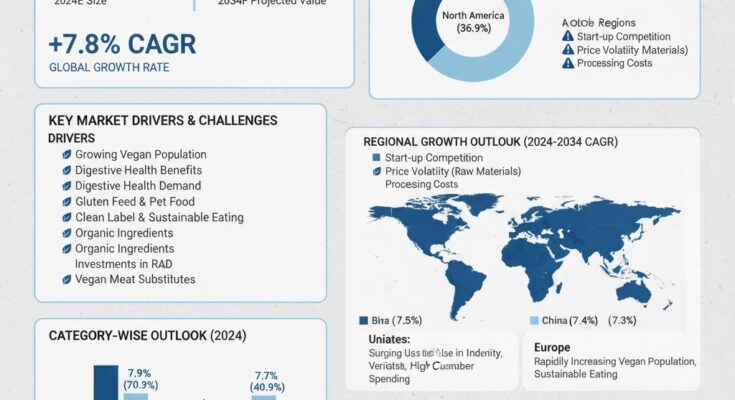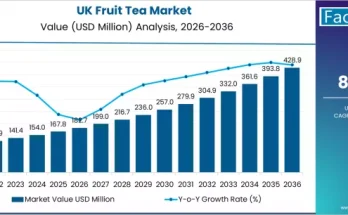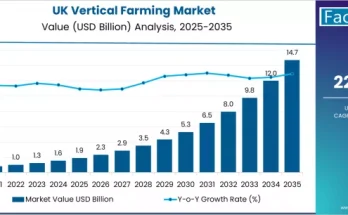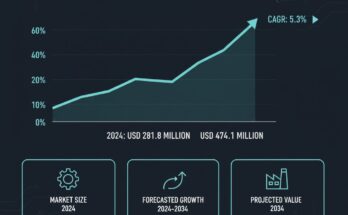The global pea fiber market is experiencing dynamic growth, driven by the rising adoption of plant-based ingredients, clean-label trends, and the expanding functional food and beverage industry. According to a recent report by Fact.MR, the global market size is estimated at US$ 23.88 billion in 2024 and is forecasted to reach US$ 50.8 billion by 2034, expanding at a CAGR of 7.8% during the forecast period.
As consumers increasingly shift toward sustainable, allergen-free, and nutritionally rich food ingredients, pea fiber is gaining prominence across diverse applications—from bakery and snacks to pet food and meat alternatives. The ingredient’s high fiber content, neutral flavor profile, and natural origin make it a preferred choice among manufacturers seeking to enhance texture, moisture retention, and digestive benefits in their products.
Strategic Market Drivers
Surge in Demand for Plant-Based and Functional Foods
The global shift toward vegan and flexitarian diets has significantly boosted the demand for pea-derived ingredients. Pea fiber, in particular, offers a sustainable, non-GMO alternative to traditional cereal and synthetic fibers. Its ability to improve satiety, gut health, and nutritional content aligns perfectly with modern wellness trends. Food manufacturers are incorporating pea fiber into protein bars, smoothies, and fortified snacks to cater to the growing health-conscious consumer base.
Clean-Label and Sustainable Ingredient Preferences
Consumers today demand transparency and minimal processing in food products. Pea fiber fits seamlessly into this clean-label movement as a naturally sourced, chemical-free ingredient with clear labeling benefits. The rising scrutiny of artificial additives and allergens such as gluten and soy further enhances the appeal of pea-based ingredients, contributing to consistent market growth.
Rising Use in Meat Alternatives and Bakery Applications
Pea fiber plays a vital role in improving the texture and water-binding properties of plant-based meats and bakery products. Its ability to mimic the mouthfeel of fat and enhance the juiciness of meat substitutes makes it indispensable for the growing alternative protein industry. Moreover, in bakery and confectionery sectors, pea fiber helps extend shelf life and improve dough structure, supporting formulation stability and quality enhancement.
Expanding Applications in Animal Nutrition
Beyond human consumption, pea fiber is witnessing robust adoption in animal feed and pet food formulations. Its high dietary fiber content promotes digestive health and supports nutrient absorption in pets and livestock. With pet humanization trends on the rise, manufacturers are focusing on natural, fiber-rich formulations, further fueling pea fiber demand.
Regional Growth Highlights
North America: Innovation and Health Awareness Driving Growth
North America remains a major market for pea fiber, supported by heightened consumer awareness of gut health and the strong presence of plant-based food manufacturers. The United States, in particular, is witnessing rapid adoption of pea fiber in high-protein snacks, meat substitutes, and nutraceuticals.
Europe: Sustainability and Clean Labels at the Core
European consumers’ focus on sustainability, ethical sourcing, and regulatory approval of novel plant-based ingredients is bolstering regional market growth. Countries such as Germany, France, and the United Kingdom are leading innovation in food formulation using pea-based fibers.
Asia Pacific: Fastest-Growing Market
Asia Pacific is emerging as the fastest-growing region in the pea fiber market, fueled by increasing disposable incomes, dietary diversification, and urbanization. China and India are key contributors, with growing demand for functional foods and fortified products targeting digestive health and wellness.
Emerging Regions: Latin America and the Middle East
Rising health consciousness, growing processed food industries, and supportive government initiatives for sustainable agriculture are creating new opportunities in Latin America and the Middle East. The expanding functional beverage and snack sector further drives adoption in these regions.
Market Segmentation Insights
By Source
- Yellow Peas dominate production due to their high fiber yield and easy availability.
- Green Peas are increasingly used in premium formulations focusing on color and flavor differentiation.
By Application
- Food and Beverages account for the largest share, with applications in bakery, snacks, and plant-based meats.
- Animal Feed is witnessing accelerating growth as manufacturers develop natural, high-fiber feed blends.
- Nutraceuticals and Dietary Supplements are an emerging segment, driven by demand for natural digestive aids.
By Product Type
- Soluble Pea Fiber: Preferred for beverages, sauces, and functional foods due to easy dispersibility.
- Insoluble Pea Fiber: Widely used in bakery, pet food, and meat analogues for improved texture and fiber content.
Challenges and Market Considerations
Despite its promising outlook, the pea fiber market faces several challenges:
- Supply Chain Fluctuations: Dependence on pea crop yields and weather conditions can impact production stability.
- Processing Costs: Advanced milling and extraction technologies increase production costs.
- Competition from Other Plant Fibers: Wheat, oat, and inulin fibers offer comparable functionality, intensifying competition.
- Regulatory Hurdles: Regional differences in labeling and food safety standards require adaptive strategies for global manufacturers.
Competitive Landscape
The global pea fiber market is characterized by strategic partnerships, capacity expansions, and innovation in product formulations. Key manufacturers are focusing on improved extraction technologies and customized pea fiber solutions for specific applications.
Prominent players include:
Emsland Group, Roquette Frères SA, Avena Foods Limited, A&B Ingredients Inc., Vestkorn Milling AS, and Puris Protein LLC.
These companies are actively investing in R&D to enhance fiber purity, solubility, and sensory properties. Strategic collaborations with food manufacturers and expansion into high-growth regions are shaping the competitive dynamics of the market.
Conclusion
The pea fiber market is entering a transformative growth phase, supported by global health trends, sustainable sourcing, and expanding plant-based product portfolios. As manufacturers innovate to meet consumer demand for clean-label, functional, and nutritionally enhanced products, pea fiber is set to play a pivotal role in the future of food and nutrition bridging the gap between sustainability and wellness.



